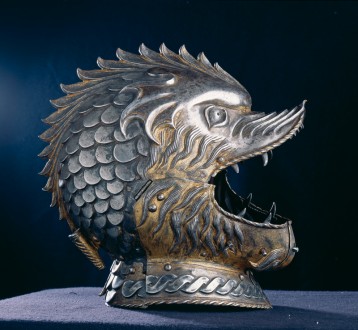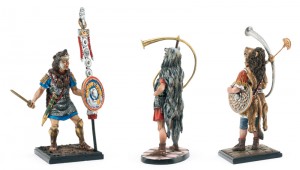Lead figurines made in the eighties from the Loriot Collection of a signifier and two cornicines of the Roman army. The signifier was a non-commissioned officer whose role was to carry a signum, a visual standard used as a rallying point and a means of communication in battle for a cohort or century. Since the signiferes had to stand in the first rank, they were extremely vulnerable, unlike the aeneator who did not have to be stand in the front line as he transmitted orders by blowing a horn. The above lead figurines are exhibited in the Cabinets Insolites. They show fully protected and recognizable Roman soldiers wearing leopard skin, head to toe, as the divinized hero Hercules. Ancient authors seldom referred to these soldiers. Consequently, the description of their various lion, bear, wolf and tiger skin wear is rather based on interpretation than of existing sources. © Paris, musée de l’Armée, Dist. RMN-GP / Émilie Cambier, Pascal Segrette

Griffon Burgonet, attributed to Milanese armourer Giovanni Paolo Negroli (1513-1569). This parade helmet is decorated with engraving and embossing of animal hair, feathers, scales, beak, curved teeth and fins. © Paris, musée de l’Armée, Dist. RMN-GP / Sebastian Straessle
Lions Armour, attributed to Milanese armourer Giovanni Paolo Negroli (1513-1569). In reference to the Twelve Labours of Hercules, the Nemean lion’s head is represented seven times on basic elements of the plate harness of this armour, such as the helm, the pauldron, the cowter and the gauntlet. This armour is on exhibit in the Salle Royale of the department of Ancient Arms and Armour. © Paris, musée de l’Armée, Dist. RMN-GP / Pascal Segrette
Human-animal
Metamorphosis
Although man is a natural predator, he possesses neither the strength, nor the agility and rapidity of most of the large animals that exist at the highest level of the food chain. Very admiring of them, man observes the refined hunting skills of the finest animals and imitates their cries and other sounds. But most of all, man, the only natural symbol-using animal, assumes animal shapes and wears animal skins as specific symbols of animals’ power, courage, strength and noble qualities. Man even takes the form or the name of an animal in order to achieve recognition among his own or to impress his opponent.
Impressive headgears
In ancient times, the warrior wore a recognizable full animal skin. With developments in technology, combat technique improvement and changes in cultural practices, only the most significant and expressive parts of the animal are worn by the soldier or reproduced on specific areas of his equipment. The protective headgear or head covering generally increases the combatant’s height, conferring him a prestigious presence; it is also one of the most important adornment in many cultures.
Furs, feathers and skins
In ancient times, animal materials were selected for their splendour, their rarity determined their value and, better still, for their qualities of durability, waterproofing and lightness. Ancient authors recorded that in the armies of the Western Roman Empire, the standard-bearers, also referred to as signiferes, wore a bearskin cap. The Grenadiers of the Imperial Guard of Napoleon I (1769-1821) wore a bearskin headdress, just like the famous Welsh Guards of the British Foot Guards nowadays.
Pliny the Younger wrote that the Romans used crests made out of ostrich plumes as a reminder of their victories in North Africa. Native American war bonnets worn by the Sioux and the Cheyenne are headdresses made from the tail feathers of the Golden Eagle, a bird considered sacred within North American Native culture as believed to carry the prayer of man between the World of Earth and the World of Spirit, and highly revered for its beauty and strength.
In ancient times, the Scythians and other Eurasian nomads wore highly protecting thick calf leather headgear. The spiked helmet worn by the German army at the beginning of the First World War was made of hardened leather.




Ajouter un commentaire